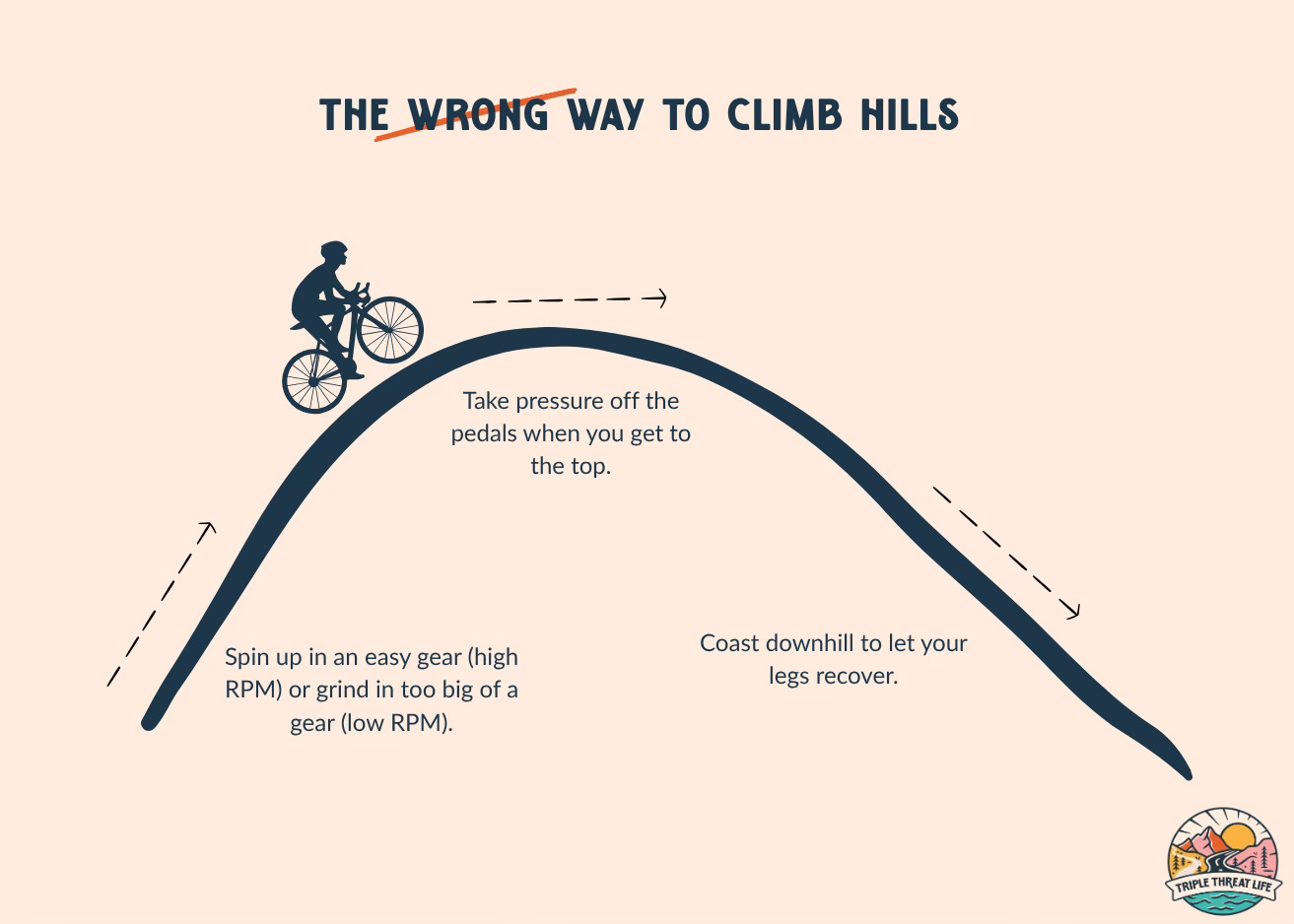The Art of the Climb: Learn How to Conquer Hills With Pro Triathlete, Justin Metzler
Pro triathlete shares smart pacing strategies for hills, speed-focused tactics, and the real key to a strong bike split.
Triple Threat Life is an email newsletter with practical triathlon tips and mindset techniques to help everyday athletes succeed. Some installments are free. Some benefits are for paid subscribers only. Sign up here.
Ah hills… I’ve always had a love/hate relationship with hilly bike courses.
On one hand, flat courses are fast and fun! But the downside of flat courses is there’s often wind. Also, there aren’t any downhills, so you’re solely reliant upon your own power.
On the other hand, a rolling bike course can tire out the legs, but it can also be very fast, because you get the assistance of gravity.
But only if you ride hills the right way. And most triathletes don’t.
I didn’t, at first. I’d stay in too low of a gear and “spin” up the hill, which feels better on the legs, but is less efficient and raises your heart rate.
Once I learned how to tackle hills the right way on a triathlon bike, it totally changed my outlook on hilly courses. Now, I can use that to my advantage and race faster for less effort!
In my latest article for IRONMAN, I talked with pro triathletes, Chris Leiferman, Justin Metzler, and Dede Griesbauer, to get some insight into racing at altitude. The piece is a promo for two 2026 races: 70.3 Boulder (5,430 ft.) and the new 70.3 Ruidoso New Mexico (6,400-7,700 ft). It provides a lot of specific advice for those two races and general tips for racing at altitude on courses with elevation gain.
Read here: Embrace the Challenge of Racing at Altitude With These Pro Tips
(FYI, they’re still finalizing course details for 70.3 Ruidoso, but at this time, the run is listed as having 1,679 ft. of gain, which I believe will make it the hilliest run course among North American 70.3 races!)
Justin Metzler is one of my favorite pros to interview, because he provides practical, easy-to-understand information that age-groupers can relate to. (It’s probably because he’s a triathlon coach as well.)
He gave me so much great info that I couldn’t fit it all into the article, so I’m putting it here on the blog!
Read on to learn Metzler’s key strategies for tackling a hilly 70.3, including smart pacing strategies, focusing on speed over power, and the real key to a strong bike split.
Altitude vs. elevation
We talk about this in the IRONMAN article in more detail, but racing at altitude is different than racing at sea level for a few reasons. At moderate altitude (3,937 ft. – 7,874 ft.) to high altitude (7,874 ft. – 11,483 ft.), the air contains less oxygen. This makes it harder for the body to deliver oxygen to the muscles, which can lead to higher heart rate, slower pace for the same effort, labored breathing, as well as increased dehydration risk.
What often comes along with racing at altitude is elevation gain, especially on the bike course. But plenty of races not at altitude have good elevation gain on the bike, like 70.3 Chattanooga (2,218 ft.), 70.3 Maine (3,249 ft.), or 70.3 Coeur d’Alene (3,445 ft.)
What many of us were taught as kids, riding a bike around the neighborhood, is opposite of how you should approach hills when riding a triathlon bike. And the way you approach climbing on the bike can make or break your entire race.
Climbing technique- speed over power
Picture this. You’re approaching a hill on your bike. You probably get out of your aerobars (if on a triathlon bike) and shift into a smaller gear, which allows your legs to “spin” up the climb at a higher cadence or RPM (revolutions per minute).
It probably feels like you’re going slow, but it’s still challenging, so your legs feel tired and you’re out of breath when you get to the top. Now you’re looking forward to that downhill! So you coast down the hill, without pedaling, to let your legs recover.
This is the wrong way to climb hills on a bike.
This method is inefficient. First, as RPM increases, so does heart rate, even if you’re pedaling in an easier gear. Have you ever tried pedaling really fast on the trainer? If so, you know this will jack up your heart rate in a hurry. This is because there’s still a physiological cost to high RPM pedaling, even if it feels easier on your legs.
Keep reading with a 7-day free trial
Subscribe to Triple Threat Life to keep reading this post and get 7 days of free access to the full post archives.




